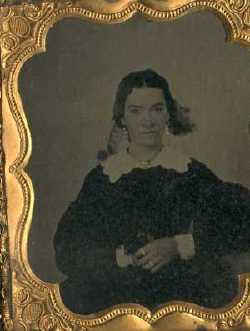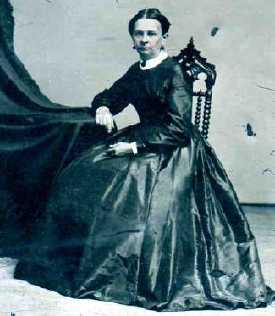Sign up for the Family Tree Newsletter Plus, you’ll receive our 10 Essential Genealogy Research Forms PDF as a special thank you!
Get Your Free Genealogy Forms
"*" indicates required fields
 |
 |
| Figure 1 | Figure 2 |
This week let’s look at two portraits of unidentified women taken between 1850 and 1865. In some periods, clothing styles changed quite dramatically from one decade to another. (Think of the period from 1965 to 1980, for instance.) In the 15 years depicted in these two images, the changes are subtle. Most women made their own clothing and could adapt existing dresses to maintain their fashionable presence. As I’ve mentioned in other columns, there are certain features in women’s clothing that help place the image within a time frame. In particular, pay attention to hairstyles, collars, accessories and the shape of sleeves.
In these two cases, the photographs’ owners know little about them. The first image of the woman in the gold frame belongs to Charlotte Powers. Her grandfather thought the woman was from the Warrick family of England. The only thing known for sure is that she lived in East Liverpool, Ohio. The second portrait belongs to Nancy Lane and her husband. He inherited it with a group of photographs—some identified, some not. Nancy thinks this woman could be her husband’s great-great-grandmother Keziah Proctor, who was the wife of Joel P. Lane. The costume details in these two portraits tell us a little about their personalities and when the women lived.
Figure 1 is wearing a simple, dark-colored dress with a wide lace collar and cuffs. Although difficult to see in this scan, her cuffs feature three scallops across the wrist. Her sleeves have a dropped shoulder with a full forearm coming into the cuff. The full skirt is not visible in this picture. Figure 2 is very conservatively dressed in a dark dress with narrow sleeves and a full skirt. If you look closely at the side of her skirt, you can see how it drapes over the hoop worn as an undergarment. Hoops became fashionable in the mid-1850s and replaced full petticoats. By the end of the 1860s, most women wore hoops except when they interfered with certain jobs.
Both women carefully selected the accessories for their portraits. Both are wearing small broaches and earrings. In the late 1850s, some women wore hair ribbons as part of their hairstyle. In figure 1 the ribbon is actually made from black netting sometimes worn in mourning. The presence of the white collar and cuffs indicates she could be in the second year of mourning since in the first year after a death, no white was worn. This woman also wears a couple of rings on one hand. Multiple thin gold rings could be worn on many fingers at once. Her accessories tell us that she was very conscious of the fashion trends. Gold paint highlights the jewelry of the first woman. If you look carefully at the pictures, you can see that the photographers tinted their cheeks pink to add color to the portraits.
Photographers often maintained a set of props to improve the visual quality of a picture. A small bouquet was added for artistic interest in the first photograph. In the 19th century, different flowers had certain meanings. Unfortunately, it is difficult to distinguish the variety of flower here. In the second image the photographer used a chair and a draped piece of furniture for props. It has an awkward appearance. Don’t you wonder why the photographer of the second picture covered up such a large piece of furniture instead of using a small table?
The costume evidence in the portraits dates both pictures. Figure 1 is from the mid to late 1850s, a period when women wore wide lace collars and cuffs. This agrees with the shape of her sleeves—tight around the upper arm and full towards the wrist. The second image is from the 1860s based on the small linen collar and narrower shape of the sleeves. A good source to learn about women’s clothing from the mid 1860s is Juanita Leisch’s Who Wore What? Women’s Wear 1861-1865 (Thomas Publications, $29.95). She devotes pages to each feature of women’s Civil War clothing, including the variety of collars worn.
Figure 1 is either an ambrotype or a tintype in a case. It is difficult to tell from only a partial scan of the image. Figure 2 is probably a paper photograph called a carte d’visite. The photographic methods support the costume dates.
Now the owners of the photographs can compare this information to their family tree. In a future article, I’d like to feature success stories based on the photo identifications submitted to this column. Please contact me if I selected one of your photographs and it helped you put a name with a face. I’d love to hear about it!
Find out how to submit your own picture for possible analysis by Maureen Taylor. E-mail her at mtaylor@taylorandstrong.com.
ADVERTISEMENT

